

|
|
Square and truncated optics reduce the total volume of conventional optical designs, such as Czerny-Turner spectrographs |
|
|
Surface mounting of square lenses directly onto a common platform improves thermomechanical stability |
|
|
High numerical aperture micro-cylindrical lenses can be used to collimate and circularize laser diodes during the packaging process |
|
|
Most standard lenses and mirrors can be cut to custom dimensions to facilitate surface mounting in compact optical systems |
When most people think of a lens, their mind immediately goes to traditional circularly symmetric, round lenses. There is a good reason for this preconception; through most of history, lens making has depended on this symmetry to precisely shape and polish spherical and aspherical lenses. This radial symmetry can serve as an invaluable tool in optomechanical design, allowing for easy centering and aligning of complex optical systems. Examples of this passive alignment process are best demonstrated by looking at the arrangement of lenses inside the tube of a microscope objective or a high-end camera lens. In both of these examples, the lenses and spacer rings self-center inside of the tube, significantly reducing the manufacturing time and cost while simultaneously providing excellent mechanical stability (Figure 1).
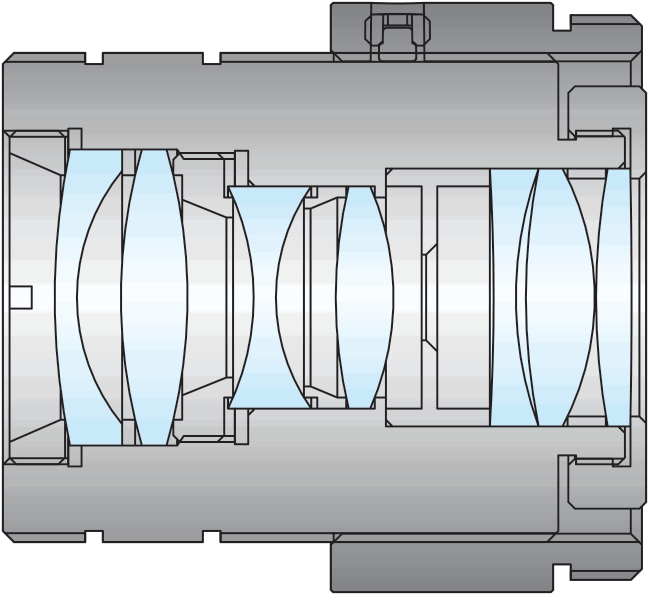
Unfortunately, as technological trends continue to push toward smaller and more compact devices, there is not always room inside of the package for excess material such as mechanical mounts or unused glass. For this reason, many modern electro-optical packages are now designed to make use of truncated or square optical components which can be mounted flat on a platform without the need for circular or V-groove mounts (Figure 2). A wide variety of photonic technologies use these components, especially in telecommunications technology such as multiplexers and amplifiers. In the interest of brevity, though, we will focus this discussion on two examples; miniature spectrometers and fiber-coupled diode lasers.
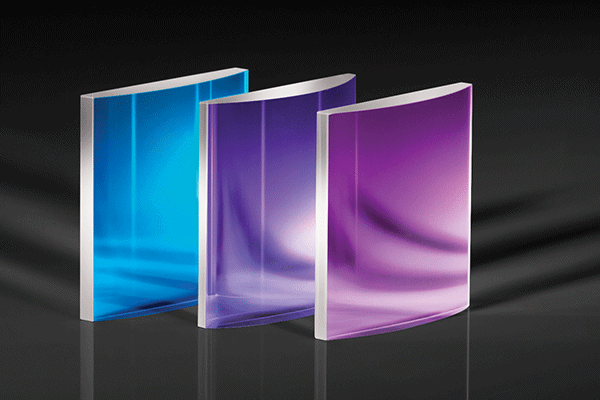
The most common optical design used in today’s miniature spectrometers is known as a Czerny-Turner configuration. In this configuration, the light from the entrance slit is collimated by a small concave mirror and then directed onto the diffraction grating (Figure 3). When the light is incident on the diffraction grating, the various wavelengths will then be dispersed along the axis parallel to the platform, but they will remain collimated. Because of this, a relatively large diameter focusing mirror is necessary to focus the plurality of slit images onto the spectrometer’s linear detector array, but this is only the case in one axis. Therefore, is it common to truncate a larger circular mirror by cutting the top and bottom off so that it can be mounted flush with the platform, significantly reducing the height of the overall system.
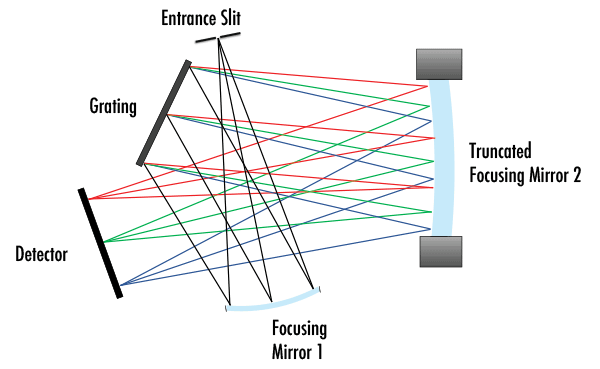
In some newer miniature and micro-spectrometer designs, this trend is taken even further, incorporating these truncated mirrors with micro-electro-mechanical system-(MEMS) based spatial light modulators instead of a diffraction grating. MEMS technology allows for a further reduction in the size of the optics, and for the detector array to be replaced by a single element photodiode, reducing the overall footprint of the spectrometer in some cases down as small as an eraser. For spectrometer designs to achieve this level of compactness, both the collimating and focusing mirror must be truncated to provide a flat edge enabling surface mounting of both optics. In this case, "pick and place" style micropositioning systems are employed for alignment of both mirrors before being epoxied in place. We will discuss micropositioning further in the following section.
While there are dozens of different laser packages commonly used for laser diodes, the 14-pin butterfly has become, for the most part, the industry standard for high-performance, fiber-coupled laser diodes. This package allows for the use of a common platform mounted onto an integrated thermoelectric cooler (TEC), providing excellent thermomechanical stability. These platforms, which are typically less than 8mm x 15mm in dimension, are made from a material such as copper tungsten, which matches the coefficient of thermal expansion (CTE) of glass. CTE matching allows for the laser diode to be operated over a wide temperature range without damaging or misaligning the optical elements inside of the package. However, using traditional round micro-optics, silicon V-groves, or metal mounting rings leads to instabilities due to the CTE mismatch, reduces the already limited space inside of the package, and offers reasonably poor alignment capabilities. The current trend in laser diode packaging is to utilize square or rectangular micro-lenses which can either be glued directly to the platform or supported in space by a secondary piece of glass through a procedure known as zero-gap mounting. These lenses offer far superior reliability, consume minimal packaging volume, and allow for sub-micron precision alignment.
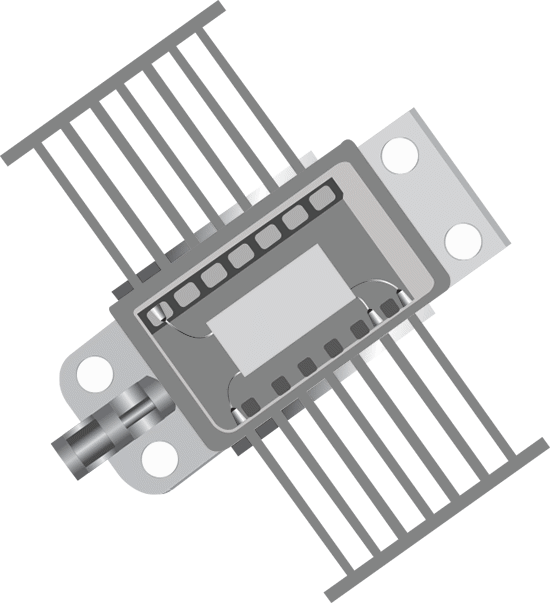
By utilizing these square optical elements, which are typically on the order of 1-3mm in size, a trained operator can use a micropositioning stage to align the optics on the platform actively. These stages consist of a vacuum pick-up tool which, when flush against the top or the side of the square optic, allows the optic to be aligned in free space with typically five degrees of freedom. Meanwhile, the output of the laser is monitored in real-time. If an operator were attempting to perform the same task with a round optic instead of a square optic, this would require the lens to be mounted into a square or rectangular lens holder, significantly increasing its total volume and reducing the maximum number of optical elements which can be fitted into the package.
In a typical fiber-coupled 14-pin butterfly package, there can be up to three individual lenses needed to provide efficient and stable coupling. Most high-end laser diodes use two cross acylindrical square micro-lenses to compensate for the differences between the divergence angles of the fast and slow axes of the laser diode. The first lens, known as the fast axis collimating (FAC) lens must have a substantial numerical aperture with a typical focal length of approximately 500µm due to the divergence angle, which generally is around 25 degrees due to the small size of the emitting aperture. Depending on the use of a single-mode or multi-mode diode, the slow axis will have a divergence angle anywhere between 3 to 5 times lower than its fast axis. Therefore, to circularize the beam, the slow axis collimating (SAC) lens must have a much longer focal length than the FAC lens. Depending on the size of the diode’s submount, these elements can easily take up to one-third of the available platform space, further illustrating the importance of utilizing square micro-optics instead of round optics. After the beam is collimated, a third square lens— typically an asphere— is needed to couple the light into the fiber optic. Just as the beam profile and divergence angle are monitored during the collimation step, the fiber coupling process is actively monitored to ensure maximum output power. For some single-mode, fiber-coupled lasers the polarization extinction ratio may also be observed. For price-sensitive laser diode systems using lower-power lasers, a single spherical or aspheric lens is often used instead of a pair of cylindrical FAC and SAC lenses.
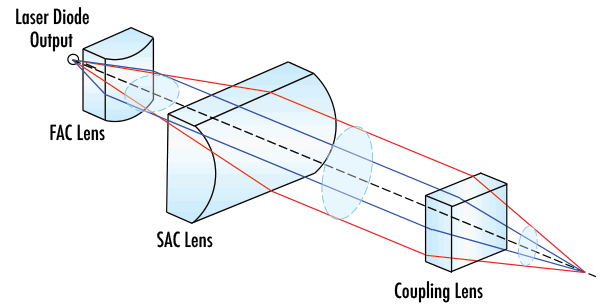
These are just two examples of how non-circular optics are used in modern electro-optic devices. As the trend toward smaller and smaller device packaging continues, square and truncated lenses and mirrors will only grow in popularity. It is essential to understand that while there are some off-the-shelf versions of these optical elements, some customization will be required the vast majority of times. While Edmund Optics® (EO) does not manufacture non-circular optics as small as 1-3mm, EO offers a wide range of standard off-the-shelf cylinder lenses with a square profile and truncates optical components as a custom service. These services are ideal for size- or weight-sensitive applications. Reach out to us to discuss our capabilities including truncation and cylindrical optics, and custom sizes in volume.
 How do truncated optics eliminate the need for kinematic mounts?
How do truncated optics eliminate the need for kinematic mounts?
 What are the advantages of cutting a round optic to square versus molding a custom square optic?
What are the advantages of cutting a round optic to square versus molding a custom square optic?
Molded square optics are an excellent choice for high volume applications, but the molding process can be prohibitively expensive. For low volume production or prototyping, it is often preferable to have a larger round optic cut into a smaller square one.
 Do you have to use cross cylindrical lenses for laser diode collimation?
Do you have to use cross cylindrical lenses for laser diode collimation?
For low-end laser devices where the beam quality and divergence angle are not as important, you can often get away with a single aspherical lens. But whenever circularization, divergence, and confocality are essential, cross cylinders are generally the most cost-effective option.
 Why is it necessary to collimate the laser diode before fiber-coupling?
Why is it necessary to collimate the laser diode before fiber-coupling?
or view regional numbers
QUOTE TOOL
enter stock numbers to begin
Copyright 2023 | Edmund Optics, Ltd Unit 1, Opus Avenue, Nether Poppleton, York, YO26 6BL, UK
California Consumer Privacy Act (CCPA): Do Not Sell or Share My Personal Information
California Transparency in Supply Chains Act